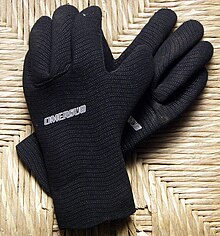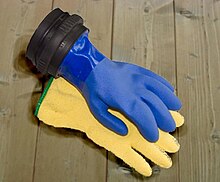Diving glove
When diving , diving gloves are primarily used to protect the hands from the cold. They are usually worn when the water is colder than 18 degrees Celsius, otherwise the fingers can become numb and dexterity is reduced. Diving gloves can also protect against mechanical injuries and against biting ( cnidarians ).
Variations
There are basically three types of diving gloves (analogous to diving suits ):
- Wet gloves are the simplest form and are made from one to seven millimeters thick neoprene . They completely enclose the hand. With a good fit, only a minimal film of water remains in between, which warms up to skin temperature due to the insulation properties. The protection against the cold increases with the thickness of the material.
- Semi-dry gloves also have double cuffs on the wrist, between which the sleeve of the diving suit can be placed. This reduces the exchange of heated water from the glove with cold ambient water when the hand is moved.
- Dry gloves keep your hands dry. For this purpose, they are sealed, or in the area of the wrist either with a latex cuff with the drysuit firmly connected. This can be done either permanently or temporarily with the help of a ring system. Dry gloves usually do not provide sufficient insulation against the cold, which is why a textile inner glove is often worn underneath.
The so-called three-finger gloves are a special form: they put middle, ring and little fingers in one compartment, while the thumb and index finger are enclosed separately. This changes the ratio of surface area to volume compared to conventional gloves and improves the insulation of the heat . In addition, larger neoprene thicknesses can be used with this shape.
Almost every year the diving industry brings new diving gloves with innovative details such as Kevlar outer coating, thermal titanium coatings or similar onto the market.
Gloves with a thicker material in particular can restrict dexterity. For this reason, there are, for example, so-called Easy Grippers, which can be pushed over the coupling of the inflator and are intended to simplify operation with gloves.
Use bans
In some diving areas it is forbidden to wear diving gloves, which is intended to encourage divers to treat the underwater world and sensitive reefs more gently and thus contribute to their preservation.
In Egypt it is illegal to wear diving gloves.
Diving sign
Since diving signs may not be given clearly enough when wearing thick diving gloves , there is an alternative variant for the "OK" sign. The thumb and index finger are brought together in a circle so that the fingertips touch each other. Middle, ring and little fingers follow the shape of the index finger and are not spread apart as with the standard ok sign.
Web links
Individual evidence
- ↑ PADI (Ed.): Open water diver manual . 2015, p. 103 .
- ↑ Gloves Off: Why Some Dive Destinations Don't Allow Gloves . In: Aquaviews - SCUBA Blog . September 28, 2014 ( leisurepro.com [accessed November 23, 2018]).
- ^ Courtney, Project Ocean Vision: Red Sea Diving Rules and Regulations. Retrieved November 23, 2018 .


